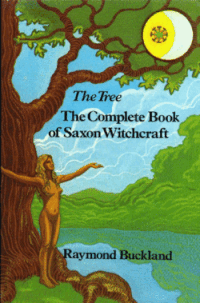This is the current revision of this page, as edited by SimLibrarian (talk | contribs) at 07:25, 11 August 2024 (combine refs). The present address (URL) is a permanent link to this version.
Revision as of 07:25, 11 August 2024 by SimLibrarian (talk | contribs) (combine refs)(diff) ← Previous revision | Latest revision (diff) | Newer revision → (diff) Tradition of the neopagan religion of Wicca| Seax-Wica | |
|---|---|
 The founding text of the Seax tradition was The Tree (1974). The founding text of the Seax tradition was The Tree (1974). | |
| Abbreviation | SW |
| Type | Syncretic Wicca |
| Orientation | Anglo-Saxon paganism inspired |
| Scripture | The Tree: Complete Book of Saxon Witchcraft |
| Governance | Priesthood |
| Region | United States |
| Founder | Raymond Buckland |
| Origin | 1973 United States |
Seax-Wica, or sometimes Seax Witchcraft, is a tradition of neopagan practice blending aspects of Wicca with the iconography of Anglo-Saxon paganism, while not seeking to reconstruct the early mediaeval religion itself.
The tradition was founded in 1973 by Raymond Buckland, an English-born high priest of Gardnerian Wicca who had recently moved to the United States. His 1974 book The Tree was written as a definitive guide to Seax-Wica, and subsequently republished in 2005 as Buckland's Book of Saxon Witchcraft.
The tradition primarily honours two principal deities: Woden and Freya, representations of the Wiccan deities the Horned God and the Mother Goddess. The tradition uses ceremonial tools such as the spear and runes.
Openness
Seax-Wica does not employ any secrecy oath. Buckland's Book of Saxon Witchcraft was written in mind that the reader would already be well versed in the various techniques of Witchcraft and Wiccan ritual. However, Buckland has pointed out that his Complete Book of Witchcraft gives instructions on how to proceed when no tools are available. These instructions are enough to allow one to begin, self-initiate, and consecrate one's first tools.
Organisation
Seax-Wica allows self-dedication as entry into its tradition, as well as solitary practice. In the Seax tradition, covens work by a form of democracy, electing, un-electing, and re-electing coven officers, the high priest and priestess. Within ritual settings, there are the thegn, a type of sergeant-at-arms/guard/watchman, who can also be responsible for the covenstead (the meeting place of the coven), or guarding a ceremony being performed; there is also a scribe/secretary, who keeps most, if not all, of the coven's records. The word "Thegn", or "Thane" is an Anglo-Saxon title (Anglo-Saxon: þeg(e)n meaning "a servant, one who does service for another.")
Buckland was not the head of the tradition, but is respected as its founder, and continued to practice and contribute to it, until his death on September 27, 2017.
See also
References
- ^ Buckland's Book of Saxon Witchcraft, ISBN 1-57863-328-1, p. xi.
- "'þegen' - Bosworth–Toller Anglo-Saxon Dictionary". bosworth.ff.cuni.cz. Retrieved 12 August 2017.
- Lyblac Anglo Saxon Witchcraft. Capall Bann Pub. 2008. ISBN 978-1-86163-287-6.
